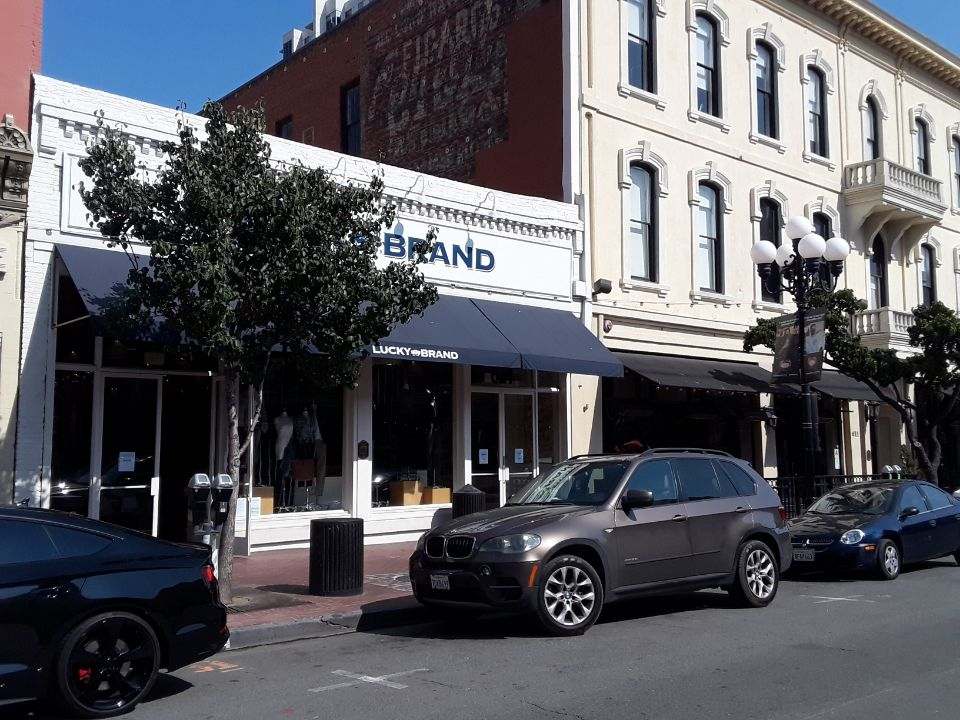Landmarks
What Goes Around, Comes Around.
The Combination Store
1880
621-625 5th Avenue
Architect – Unknown
Architectural Style – Victorian Commercial Storefront
The Combination Store is one of the oldest buildings in the Gaslamp, and consequently , the building and the property on which it sits have a long convoluted history. This one-story, rather modestly adorned brick structure, predates the elaborate brick building next to it, the Yuma Building, which is often referred to as the “oldest, all-brick building.”
As with all lots in the downtown area, this land parcel was purchased from Alonzo Horton by Frank Caillard. Caillard purchased several lots from Horton in 1868, and six years later, sold many of them, including the store lot, to Peter Peterson and his wife, Mary. By November of 1874, Peterson had added a small dwelling to the property and declared it a homestead. Just one month later, the Petersons released their claim to the property back to Mr. Caillard for $1,000 in gold coin. The property was traded around for the next few years until 1880, when it was acquired by Charles R. Dauer and C.C. Westover.
Though no specific reference can be found as to the exact date of construction, several references in the San Diego Union infer that the “Combination Store” was built in 1880 by its original owners, Mr. Dauer and Mr. Westover. The structure was a one story brick building with a 36- inch parapet, a metal cornice and a frame porch. It had a composition roof with dentil detailing, and extended 70 feet deep into the lot. As the lot was narrow but long, this left 30 feet vacant. When the structure was complete, the owners added a 5400 pound safe and a large, artistically rendered sign over the porch.
The store sold dry goods and clothing, and carried stock purchased from Leopold Brothers and Company of Chicago. one of the largest clothing firms in the United States. The business prospered, and was again mentioned in late September of 1881 in the San Diego Union, which stated that “Messrs. Dauer and Westover of the Combination Store, are removing their stock of goods into the new McGurck building next door to their former place of business.” This, however, was “fake news,”as this never occurred. The New York and Boston Combination Company, as it was sometimes called, remained in its original location until 1896. The only modification to the business occurred in 1886, when a single-story frame shed with a shingle roof was added to the rear of the store. In 1887, the San Diego City and County Directories stated that, “Messrs. Dauer and Westover, proprietors, carry besides nearly everything else known to a complete department store, a most elegant and complete line of dry goods.”
By 1889-1890, Dauer and Westover sold the Combination Store to a new proprietor, Tobias Czerwinsky. At this time, Mr. Westover left the San Diego area, and Mr. Dauer became involved in city politics. He served as County Treasurer from 1891-1893.
Czerwinsky, experienced in the dry goods business, expanded the Combination Store to include wholesale as well as retail trade. He had previously been a businessman in Tucson, Arizona and in Baja California. After his death in 1894, a relative, Julius Czerwinsky, took over the business. Unfortunately, he was not as skilled as his predecessor, and the business was closed due to bankruptcy in 1896.
The building then remained empty until 1903, when it was opened as a grocery store by A. Sidney Smith. After three years, Smith turned over proprietorship to James and Henry Stansfield, who occupied the building until 1910. After they left, the structure remained vacant once more until 1914. When the building reopened in 1914, the structure had been subdivided into two storefronts, a clothing store and a shoe store.
Throughout the ensuing years , the properties housed a variety of businesses including a jewelry store, a men’s furnishing store , a beverage store, cigar store, barber shops, a shoeshine store and a bar. Both adjoining stores have a history of being taverns from 1935 – 1979. In the early to late 1980s, both sides were converted to the Follies Theater, an adult entertainment venue.
Today, the building remains relatively unscathed and unchanged, except for the removal of the porch and a shortening of the parapet. It now houses Lucky Brand, a trendy clothing and shoe store, harkening back to its origins. Fine clothing never goes out of style!
Sandee is the Historian for the Gaslamp Quarter Historical Foundation. She can be reached at [email protected].

